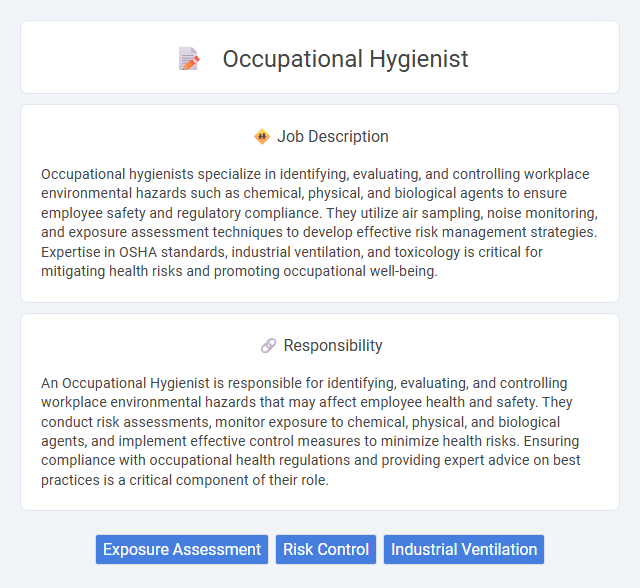
Occupational hygienists specialize in identifying, evaluating, and controlling workplace environmental hazards such as chemical, physical, and biological agents to ensure employee safety and regulatory compliance. They utilize air sampling, noise monitoring, and exposure assessment techniques to develop effective risk management strategies. Expertise in OSHA standards, industrial ventilation, and toxicology is critical for mitigating health risks and promoting occupational well-being.
Individuals with strong attention to detail and a keen interest in workplace safety and health are likely suitable for a career as an Occupational Hygienist. This role may appeal to those who enjoy analyzing environmental factors, such as air quality, noise levels, and chemical exposures, to protect employee well-being. People who prefer working in dynamic environments and can handle both fieldwork and data interpretation probably find this job fulfilling and well-matched to their skills.
Qualification
An Occupational Hygienist typically requires a bachelor's degree in occupational health, industrial hygiene, or a related field, often complemented by professional certification such as the Certified Industrial Hygienist (CIH) credential. Expertise in risk assessment, exposure monitoring, and regulatory compliance is essential for ensuring workplace safety and health standards. Continuous education and hands-on experience in identifying and controlling environmental hazards further strengthen qualifications in this specialized profession.
Responsibility
An Occupational Hygienist is responsible for identifying, evaluating, and controlling workplace environmental hazards that may affect employee health and safety. They conduct risk assessments, monitor exposure to chemical, physical, and biological agents, and implement effective control measures to minimize health risks. Ensuring compliance with occupational health regulations and providing expert advice on best practices is a critical component of their role.
Benefit
An Occupational Hygienist likely improves workplace safety by identifying and mitigating environmental hazards, which reduces the risk of employee illness and injury. They probably enhance regulatory compliance, helping companies avoid costly fines and legal issues. Their expertise may lead to increased productivity and employee well-being through healthier work environments.
Challenge
Occupational hygienists likely face the challenge of accurately assessing workplace hazards that vary widely across industries, requiring continuous adaptation to new technologies and regulations. They probably encounter difficulties in implementing effective control measures while balancing employee safety with operational productivity. Managing resistance from both employers and workers toward necessary safety changes may also present a significant obstacle in their efforts to maintain a healthy work environment.
Career Advancement
An Occupational Hygienist's career advancement often involves gaining specialized certifications such as Certified Industrial Hygienist (CIH) or Registered Occupational Hygienist (ROH). Progression typically leads to senior positions in risk assessment, toxicology, or environmental health and safety management within industries like manufacturing, construction, and healthcare. Expertise in regulatory compliance and exposure control technologies significantly enhances opportunities for leadership roles and consultancy.
Key Terms
Exposure Assessment
Occupational Hygienists specialize in Exposure Assessment by identifying and evaluating workplace hazards such as chemical, biological, and physical agents to ensure worker safety. They utilize monitoring equipment and analytical techniques to measure exposure levels and compare them to regulatory standards like OSHA Permissible Exposure Limits (PELs) or ACGIH Threshold Limit Values (TLVs). Their assessments inform the implementation of control measures, reducing health risks and ensuring compliance with occupational health regulations.
Risk Control
Occupational hygienists specialize in identifying, evaluating, and controlling workplace hazards to prevent illness and injury. They implement engineering controls, administrative policies, and personal protective equipment to mitigate risks related to chemical, physical, biological, and ergonomic exposures. Effective risk control strategies decrease workplace incidents and ensure compliance with occupational health and safety regulations.
Industrial Ventilation
Occupational hygienists specializing in industrial ventilation design and assess ventilation systems to control airborne contaminants in workplaces, ensuring compliance with OSHA and ACGIH standards. They conduct air quality monitoring, evaluate ventilation effectiveness, and recommend engineering controls to minimize exposure to hazardous dust, fumes, and gases. Expertise in ventilation system analysis helps protect worker health, improve indoor air quality, and reduce occupational illness risks.
 kuljobs.com
kuljobs.com